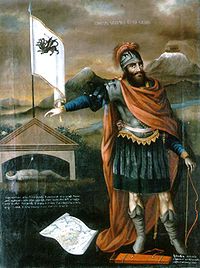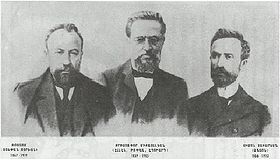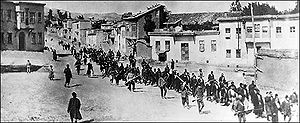
Armenian nationalism
Encyclopedia

Romantic nationalism
Romantic nationalism is the form of nationalism in which the state derives its political legitimacy as an organic consequence of the unity of those it governs...
of Mikayel Chamchian
Mikayel Chamchian
Mikayel Chamchian was an Armenian Mekhitarist monk and historian.-Career:Chamchian was born in Istanbul and trained as a jeweler by the imperial jeweler Mikayel Chelebi Diuzian. He joined the Mekhitarian order in Venice in 1762.In 1774 he was appointed instructor of Armenian language in the...
(1738–1823) and generally defined as the creation of a free, independent and united Armenia
Greater Armenia (political concept)
Greater Armenia or United Armenia refers to an irredentist concept of the territory claimed by some Armenian nationalist groups outside the Republic of Armenia which are considered part of national homeland by Armenians, based on the present-day and historical presence of Armenian...
formulated as the Armenian Cause . Armenian national awakening developed in the 1880s in the context of the general rise of nationalism under the Ottoman Empire
Rise of nationalism under the Ottoman Empire
The rise of the Western notion of nationalism under the Ottoman Empire eventually caused the break-down of the Ottoman millet concept...
. The Russian Armenia
Russian Armenia
Russian Armenia is the period of Armenia's history under Russian rule beginning from 1829, when Eastern Armenia became part of the Russian Empire to the declaration of the Democratic Republic of Armenia in 1918...
followed with significant causes. The Armenian Apostolic Church
Armenian Apostolic Church
The Armenian Apostolic Church is the world's oldest National Church, is part of Oriental Orthodoxy, and is one of the most ancient Christian communities. Armenia was the first country to adopt Christianity as its official religion in 301 AD, in establishing this church...
has been a great defender of Armenian nationalism, with leaders like Khrimian Hayrik who devoted his life to the peasantry. The establishment of modern Armenia
Armenia
Armenia , officially the Republic of Armenia , is a landlocked mountainous country in the Caucasus region of Eurasia...
(1991) and Armenian social fabric becoming more complex gradually decrease the political influence of Hay Dat and shifted towards a modern Armenian nationalism modeled as a liberal nationalism. On the other hand, the Armenian diaspora
Armenian diaspora
The Armenian diaspora refers to the Armenian communities outside the Republic of Armenia and self proclaimed de facto independent Nagorno-Karabakh Republic...
have "diaspora nationalism," which maintain that the threat of assimilation rather than economic advantage.
National awakening
The situation of the non-Muslim minorities within the Ottoman Empire changed substantially as a result of reforms introduced during the TanzimatTanzimat
The Tanzimât , meaning reorganization of the Ottoman Empire, was a period of reformation that began in 1839 and ended with the First Constitutional Era in 1876. The Tanzimât reform era was characterized by various attempts to modernize the Ottoman Empire, to secure its territorial integrity against...
era. The early reforms were generally addressed at changing the organisation of, and systems within, the Ottoman Empire as a whole. However, as a result of diplomatic pressures exerted by the Great Powers that had supported the Ottoman Empire against Russia during the Crimean War
Crimean War
The Crimean War was a conflict fought between the Russian Empire and an alliance of the French Empire, the British Empire, the Ottoman Empire, and the Kingdom of Sardinia. The war was part of a long-running contest between the major European powers for influence over territories of the declining...
, in 1856 reforms were made that sought to give non-Muslims citizens of the Ottoman Empire the same rights as Muslim citizens. The capitation tax
Jizya
Under Islamic law, jizya or jizyah is a per capita tax levied on a section of an Islamic state's non-Muslim citizens, who meet certain criteria...
on non-Muslims was abolished, non-Muslims were allowed to become soldiers, and schools for the non-Muslim communities were allowed to open.
Under these new and relatively liberal conditions, many Armenian schools were opened throughout the Ottoman Empire. The majority of these schools quickly acquired a secular aspect. The Armenians also established numerous cultural associations to set a minimum standard for the curricula and qualifications for the teachers. In 1880 these associations united together as the "General Union of Armenian Schools".
After the defeat of the Ottoman Empire in the Russo-Turkish War of 1877-78, the Armenian National Assembly
Armenian National Assembly (Ottoman Empire)
Armenian National Assembly was the governing body of the Armenian Millet established by Armenian National Constitution of 1863 under Ottoman Empire....
and Patriarch Nerses II of Constantinople sent Catholicos Mgrdich Khrimian to the Congress of Berlin
Congress of Berlin
The Congress of Berlin was a meeting of the European Great Powers' and the Ottoman Empire's leading statesmen in Berlin in 1878. In the wake of the Russo-Turkish War of 1877–78, the meeting's aim was to reorganize the countries of the Balkans...
to represent the Armenians in the debate on the "Armenian Question
Armenian Question
The term "Armenian Question" as used in European history, became common place among diplomatic circles and in the popular press after the Congress of Berlin; that in like Eastern Question, refers to powers of Europe's involvement to the Armenian subjects of the Ottoman Empire beginning with the...
". In his famous patriotic speech "The Paper Ladle" Mgrdich Khrimian advised Armenians to take the national awakening of Bulgaria
National awakening of Bulgaria
Bulgarian nationalism emerged in the early 19th century under the influence of western ideas such as liberalism and nationalism, which trickled into the country after the French revolution, mostly via Greece, although there were stirrings in the 18th century. Russia, as fellow Orthodox Slavs, could...
as a model as the hopes of the Armenian people for self-determination.
Article 61 of the Berlin Congress
Congress of Berlin
The Congress of Berlin was a meeting of the European Great Powers' and the Ottoman Empire's leading statesmen in Berlin in 1878. In the wake of the Russo-Turkish War of 1877–78, the meeting's aim was to reorganize the countries of the Balkans...
mentioned the possibility of an "autonomous Armenia", transforming the "Armenian Question" from an internal problem of the Ottoman Empire into an international one. In the treaty, Ottoman Turkey undertook to protect its Armenian subjects from oppression and violence. However, the treaty did not provide any instruments to force Turkey to make reforms. Both Turkey and Russia began to look upon all expressions of Armenian national identity, however innocent, as possible instruments for the realisation of that autonomy.
Role of ancient history
ArmeniansArmenians
Armenian people or Armenians are a nation and ethnic group native to the Armenian Highland.The largest concentration is in Armenia having a nearly-homogeneous population with 97.9% or 3,145,354 being ethnic Armenian....
are the original inhabitant of much of the territory of historic Armenia, and the Turks cannot claim presence in Anatolia prior to the Seljuk
Great Seljuq Empire
The Great Seljuq Empire was a medieval Persianate, Turko-Persian Sunni Muslim empire, originating from the Qynyq branch of Oghuz Turks. The Seljuq Empire controlled a vast area stretching from the Hindu Kush to eastern Anatolia and from Central Asia to the Persian Gulf...
conquests of the 11th century. The suggestion that the Armenians had also been newcomers to the region, even if 1500 years earlier than the Turks, might rise, within the logic of ethnic nationalism
Ethnic nationalism
Ethnic nationalism is a form of nationalism wherein the "nation" is defined in terms of ethnicity. Whatever specific ethnicity is involved, ethnic nationalism always includes some element of descent from previous generations and the implied claim of ethnic essentialism, i.e...
, the possibility that Turkish and Armenian claims to the territory were "morally equal". Identification with the distant glories of Urartu and its prehistoric forerunners can be used to reassert Armenian "indigeneity" and "compensate for modern miseries", and together with Mount Ararat
Mount Ararat
Mount Ararat is a snow-capped, dormant volcanic cone in Turkey. It has two peaks: Greater Ararat and Lesser Ararat .The Ararat massif is about in diameter...
has come to be a powerful symbol of Armenian ethnicity especially among the second generation diaspora
Armenian diaspora
The Armenian diaspora refers to the Armenian communities outside the Republic of Armenia and self proclaimed de facto independent Nagorno-Karabakh Republic...
(Redgate 1995).
As a consequence, essentialist
Essentialism
In philosophy, essentialism is the view that, for any specific kind of entity, there is a set of characteristics or properties all of which any entity of that kind must possess. Therefore all things can be precisely defined or described...
interpretations of Armenian ethnicity over the ages abound in Armenian historiography, and flourished particularly during the Soviet era, with examples such as S. A. Sardarian's Pervobytnoye obshchestvo v Amenii of 1967 which besides "numerous plagiarisms and mistakes" goes as far as to postulate a separate Armenian race native to the Armenian plateau, and attributes the invention of metallurgy to the Armenians (Kohl and Tsetskhladze 1995). Heavily slanted depictions of Urartu are common in this literature. There are reasonable scholarly scenarios that there was a Proto-Armenian component in Urartu, and that the early Armenians were the bona fide cultural heirs to Urartu, but the essentialist view of Armenian nationhood that simply equates Urartu with Armenia cannot be sustained (Kohl and Tsetskhladze 1995).
Russian Armenia

Ottoman Empire
The Ottoman EmpireIt was usually referred to as the "Ottoman Empire", the "Turkish Empire", the "Ottoman Caliphate" or more commonly "Turkey" by its contemporaries...
during the Hamidian massacre.
Armenian Genocide


Armenians
Armenian people or Armenians are a nation and ethnic group native to the Armenian Highland.The largest concentration is in Armenia having a nearly-homogeneous population with 97.9% or 3,145,354 being ethnic Armenian....
s took a worse course within the Ottoman Empire
Ottoman Empire
The Ottoman EmpireIt was usually referred to as the "Ottoman Empire", the "Turkish Empire", the "Ottoman Caliphate" or more commonly "Turkey" by its contemporaries...
, with World War I
World War I
World War I , which was predominantly called the World War or the Great War from its occurrence until 1939, and the First World War or World War I thereafter, was a major war centred in Europe that began on 28 July 1914 and lasted until 11 November 1918...
followed by the Armenian Genocide
Armenian Genocide
The Armenian Genocide—also known as the Armenian Holocaust, the Armenian Massacres and, by Armenians, as the Great Crime—refers to the deliberate and systematic destruction of the Armenian population of the Ottoman Empire during and just after World War I...
, in which up to 1,500,000 Armenian
Armenians
Armenian people or Armenians are a nation and ethnic group native to the Armenian Highland.The largest concentration is in Armenia having a nearly-homogeneous population with 97.9% or 3,145,354 being ethnic Armenian....
s were killed. Following World War I
World War I
World War I , which was predominantly called the World War or the Great War from its occurrence until 1939, and the First World War or World War I thereafter, was a major war centred in Europe that began on 28 July 1914 and lasted until 11 November 1918...
, the Armenians not scattered in the Armenian diaspora
Armenian diaspora
The Armenian diaspora refers to the Armenian communities outside the Republic of Armenia and self proclaimed de facto independent Nagorno-Karabakh Republic...
found themselves after the fall of the short-lived Democratic Republic of Armenia
Democratic Republic of Armenia
The Democratic Republic of Armenia was the first modern establishment of an Armenian state...
reduced to a minor republic within the Soviet Union
Soviet Union
The Soviet Union , officially the Union of Soviet Socialist Republics , was a constitutionally socialist state that existed in Eurasia between 1922 and 1991....
, the Armenian SSR
Armenian SSR
The Armenian Soviet Socialist Republic The Armenian Soviet Socialist Republic The Armenian Soviet Socialist Republic The Armenian Soviet Socialist Republic The Armenian Soviet Socialist Republic The Armenian Soviet Socialist Republic The Armenian Soviet Socialist Republic The Armenian Soviet...
. See (Victor's justice
Victor's justice
The label "victor's justice" is a situation in which an entity partakes in carrying out "justice" on its own basis of applying different rules to judge what is right or wrong for their own forces and for those of the enemy. Advocates generally charge that the difference in rules amounts to...
)
Modern times & resistance against Turkish ultranationalism
An Historic Armenia was advocated by the Armenian Revolutionary FederationArmenian Revolutionary Federation
The Armenian Revolutionary Federation is an Armenian political party founded in Tiflis in 1890 by Christapor Mikaelian, Stepan Zorian, and Simon Zavarian...
during Soviet times, which would incorporate Nakhchivan in Azerbaijan, and Eastern Turkey (western parts of Armenian Highland
Armenian Highland
The Armenian Highland is the central-most and highest of three land-locked plateaus that together form the northern sector of the Middle East...
). Armenian nationalism in the 20th century emphasized the "ancient origin of the Armenians", and consequently embraced the Armenian hypothesis of Indo-European origins forwarded by Soviet scholars in the 1980s. During Soviet times, Armenian nationalism within Soviet Armenia was distinguished from other nationalisms of peoples absorbed into the Soviet Union, such as Georgian, Ukrainian or Estonian, in that it did not direct itself against the dominant Russians, but continued to focus on the traditional enemy, the Turks, and was consequently subtly encouraged by the communist government. Armenia
Armenia
Armenia , officially the Republic of Armenia , is a landlocked mountainous country in the Caucasus region of Eurasia...
emerged as an independent state in 1991.
Armenian nationalism has notably been opposed to Turkish nationalism
Turkish nationalism
Turkish nationalism is a political ideology that promotes and glorifies the Turkish people, as either a national, ethnic or linguistic group and puts the interests of the state over other influences, including religious ones.-Pan-Turkism:...
. According to Brannen (2004), to the Armenian diasporic communities in the United States and Canada, historical memory of the Armenian Genocide
Armenian Genocide
The Armenian Genocide—also known as the Armenian Holocaust, the Armenian Massacres and, by Armenians, as the Great Crime—refers to the deliberate and systematic destruction of the Armenian population of the Ottoman Empire during and just after World War I...
carried out by Ottoman Turks and Kurds in April 1915 has become a focus around which formation of Armenian identity takes place. Armenian diasporic nationalism has a strong nostalgic component for a lost time and place, most prominently symbolized by Mount Ararat
Mount Ararat
Mount Ararat is a snow-capped, dormant volcanic cone in Turkey. It has two peaks: Greater Ararat and Lesser Ararat .The Ararat massif is about in diameter...
which, although visible from Yerevan
Yerevan
Yerevan is the capital and largest city of Armenia and one of the world's oldest continuously-inhabited cities. Situated along the Hrazdan River, Yerevan is the administrative, cultural, and industrial center of the country...
, lies within Turkish territory.
See also
- Rise of nationalism under the Ottoman EmpireRise of nationalism under the Ottoman EmpireThe rise of the Western notion of nationalism under the Ottoman Empire eventually caused the break-down of the Ottoman millet concept...
- Azerbaijani nationalismAzerbaijani nationalismAzerbaijani nationalism was relatively slow to develop under the communists. "Rather than imagining themselves as part of a continuous national tradition, like the Georgians and Armenians, the Muslims of Transcaucasia saw themselves as part of the larger Muslim world, the umma." After the end of...
- ASALAAsalaAsala may refer to:* Armenian Secret Army for the Liberation of Armenia, a Marxist-Leninist guerrilla organization.* Asalah Nasri, Syrian singer* Al Asalah, a Salafist political party in Bahrain...
- Armenian Aryan UnionArmenian Aryan UnionThe Armenian Aryan Union is an ultra-nationalist ethnocentric and antisemitic political party in Armenia. Its leader, one Armen Avetisian has received a suspended three years' sentence in 2005 by Yerevan court for inciting ethnic hatred in a series of interviews in which he branded the Jews as...
- Mighty FatherlandMighty FatherlandThe Mighty Fatherland is a nationalist political party in Armenia.At the last elections, 25 May 2003, the party won 3.3 % of popular votes and no seats....
- Armenian Secret Army for the Liberation of ArmeniaArmenian Secret Army for the Liberation of ArmeniaThe Armenian Secret Army for the Liberation of Armenia or ASALA was an Armenian nationalist militant organization, that operated from 1975 to 1986. The group also operated under other names such as The Orly Group and the 3 October Organization...
- Nairi (Armenian usages)Nairi (Armenian usages)During the late nineteenth century rise of nationalism under the Ottoman Empire, the word "Nairi" or "Nayiri" came to be used as a synonym for Armenia among Armenians who came to see the Nairi , a people located in the wider area of the Armenian Highlands during the Late Bronze...
- Nationalism and ancient history
- Martiros KavoukjianMartiros KavoukjianArmenia, Subartu And Sumeris inspired by the Armenian hypothesis of Indo-European origins. It seeks to establish an ethnic Armenian identity for the Armani mentioned by Naram-Sin, for "Armani-Subari connections" and "Armani-Subari-Sumer relations"...

